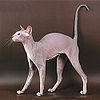
Peterbald
Encyclopedia
Appearance
Peterbalds have an elegantly slim graceful and muscular build. They have a narrow and long head with a straight profile, almond-shaped eyes, wedge-shaped muzzle, and big set-apart ears. They have a long whippy tail, webbed feet and oval paws that allow them to grasp objects and open levered doorknobs. They are somewhat similar in appearance to Oriental ShorthairOriental Shorthair
The Siamese cat was imported to Britain from Siam in the later half of the 1800s. According to reports, both pointed and solid colors were imported. The gene that causes the color to be restricted to the points is a recessive gene, therefore the general population of the cats of Siam were largely...
cats. They have a hair-losing gene and can be born bald, flocked, velour, brush, or with a straight coat. Those born with hair, except the straight-coats, can lose their hair over time. The Peterbald comes in all colors and markings.
.
Temperament
Peterbalds are sweet-tempered, affectionate, peaceful, curious, smart and energetic. They are medium vocal and tend to follow their owners and always be with them. Peterbalds typically live in harmony with other cats and pets, and also with children.History

Don Sphynx
The Donskoy is a hairless cat breed of Russian origin. This breed started in 1987 with the discovery of a hairless cat in the Russian city of Rostov-on-Don by cat breeder Elena Kovaleva...
(also known as Don Sphynx
Don Sphynx
The Donskoy is a hairless cat breed of Russian origin. This breed started in 1987 with the discovery of a hairless cat in the Russian city of Rostov-on-Don by cat breeder Elena Kovaleva...
, Donskoy or Donsky) male named Afinogen Myth and an Oriental Shorthair
Oriental Shorthair
The Siamese cat was imported to Britain from Siam in the later half of the 1800s. According to reports, both pointed and solid colors were imported. The gene that causes the color to be restricted to the points is a recessive gene, therefore the general population of the cats of Siam were largely...
female World Champion named Radma von Jagerhov, by Russian felinologist Olga S. Mironova. The first two litters produced four Peterbald kittens: Mandarin iz Murino, Muscat iz Murino, Nezhenka iz Murino and Nocturne iz Murino. These four Peterbalds were the founders of the breed.
In 1996, the breed was adopted in the Russian Selectional Feline Federation (SFF) and given a standard and an abbreviation (PBD). In 1997 it was adopted in The International Cat Association (TICA) with the abbreviation PB, and in 2003 in the World Cat Federation (WCF) with the abbreviation PBD. Other used handles of the breed are PBD, PTB, PD and PSX.
These days the breed develops in the direction of modern Oriental and Siamese types, that is to say a long muzzle, large set-apart ears, flat cheekbones, and an elegant body on long legs. Therefore, all standards for this breed encourage mating with Oriental and Siamese cats and semi-longhair variations of those (such as Balinese
Balinese (cat)
The Balinese is breed of domestic cat with long hair and Siamese-style point coloration. It is essentially a Siamese but with a medium-length silky coat, and a plumed tail.-History:The "Balinese" is not actually from Bali or any part of Indonesia...
and Javanese
Javanese (cat)
The Javanese is a breed of domestic cat recognized by cat fanciers as a show cat, more specifically an oriental longhair.-Origin:The Javanese cat is not from Java nor Indonesia. Genetically they are long-haired Oriental."....
). The Balinese and Javanese were eliminated from the acceptable outcross list in 2005.
The Peterbald was accepted for Championship class competition, effective May 1, 2009, in the American Cat Fanciers Association (ACFA) in August 2008. Effective May 2008, TICA recognizes the "brush coat" Peterbald for Championship competition.

